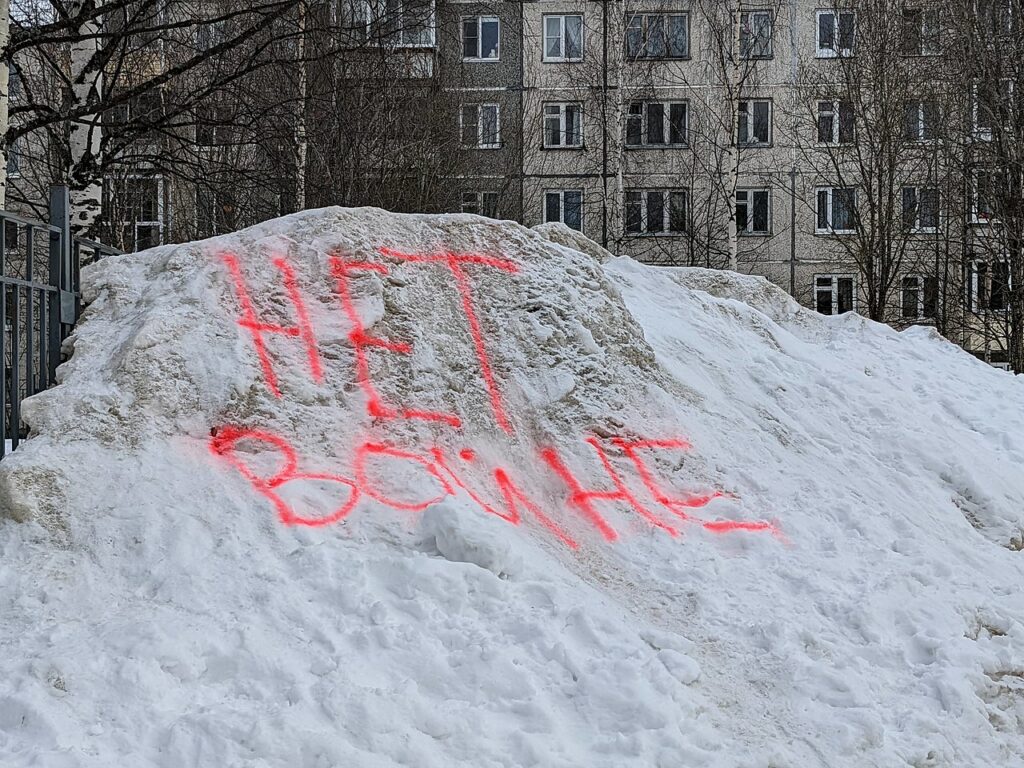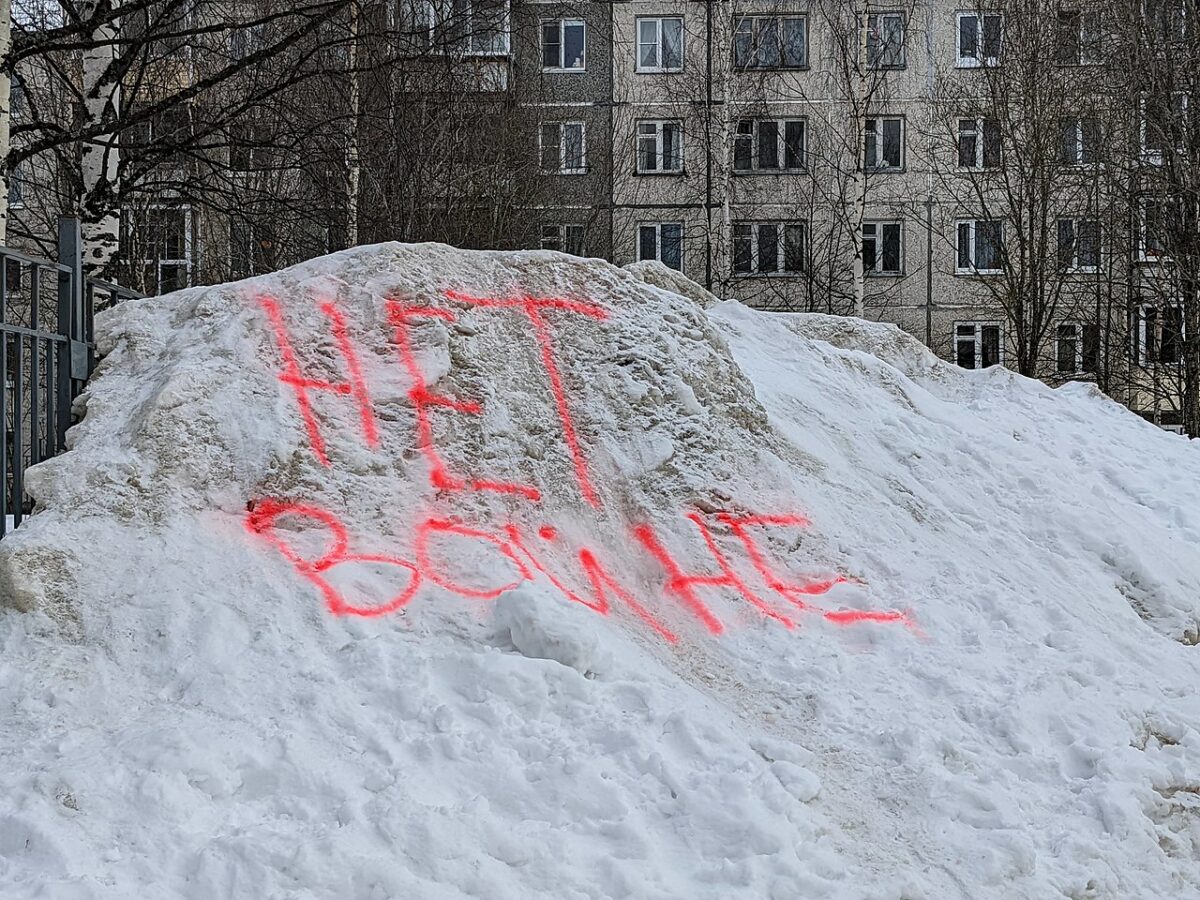Public protest has always been a risky affair in Russia, but it has become even riskier as of late. As anti-war demonstrations swept the country earlier this year, the repressive state apparatus intensified, and the protest has been cast underground. Nevertheless, the most committed activists have remained defiant in the face of suppression, coming up with creative new ways to spread their anti-war message to the masses.

It is well known that Vladimir Putin’s regime has not been particularly accommodating when it comes to public protest. While the Russian Constitution guarantees the citizens the right to peaceful assembly, the Federal Law requires the organisers to notify and come to an agreement with the local authorities on the event logistics to make it “authorised”. If the event is “unauthorised”, an ordinary participant may be facing a fine of up to 20,000 roubles ($320), up to 100 hours of community service or up to 15 days of “administrative arrest” (incarceration with no criminal record). Repeated offence of the same public event-related legislation within a short period may turn this otherwise administrative offence into a criminal one, with fines up to three annual salaries, up to 480 hours or 2 years of community service or up to 5 years or penal labour or incarceration.
Despite all of this, people in different parts of Russia continued to go out and exercise their constitutional right, whether with or without an “authorisation”. Some of them attained their goals – from freeing a journalist (Ivan Golunov) detained by police under dubious circumstances to winning an eco-battle against the local authorities and private companies (in Shiyes and Kushtau). At the same time, those who protested against the actions of the federal authorities, whether challenging the raising of the pension age or the arrest of a governor in Russia’s Far East (Sergei Furgal), usually got nowhere. As for those who organised and participated in “unauthorised” protests, such as those that followed the detention of Alexei Navalny in 2021, they risked the most.
State vs Anti-war activists
Putin’s Ukraine speech on 24th February 2022 could only mean one thing for the political dissenters in Russia – their lives were about to go from bad to worse. Nevertheless, the next few weeks saw the longest street protest campaign since “Free Furgal” in 2020 and the most numerous and widespread since “Free Navalny” in 2021. Both the ideological and repressive state apparatuses did not take long to respond. More “foreign agent” designations, more bans, more detentions. Speaking of the latter, if out of the 10,000+ people who came out to demand the release of Navalny across the country on 21st April 2021 under 2,000 were detained, out of approximately 5,200 anti-war protesters who came out nationwide on 6th March of this year around 5,000 were detained. Clearly, the authorities were not willing to tolerate any opposition to what they had designated as a “special military operation”. Furthermore, several new laws were introduced which boded punishments for those convicted of spreading false information regarding the armed forces of the Russian Federation. Depending on a variety of factors, one could be fined up to 5 million roubles (over $80K) or face up to 5 years of penal labour or up to 15 years of incarceration. It is hardly surprising that under these circumstances much of the protest has gone underground.
Toys in anti-war protest
Looking at the tactics used by the anti-war activists in Russia, some of them have been fairly standard, along the lines of leaving anti-war leaflets, stickers, graffiti and posters in public places. A lot of them have borrowed from the universal anti-war repertoire – for instance, toys with anti-war messages or red paint on them to stress that war takes not only adults’ but also children’s lives. Another one was a Putin doll holding up a “war criminal” sign, echoing the earlier campaigns around the world against the NATO’s wars and the Bill Clinton, George W Bush, Barack Obama and Tony Blair “war criminal” dolls accompanying them. However, one big difference is that in the more liberal countries such as the US and the UK, anti-war protesters have been able to come out in the broad daylight and express their opposition to their ruling regimes’ military attacks against Iraq, Yugoslavia, Libya, etc. In the illiberal Russia, the protesters must leave their anti-war messages discreetly, making sure that no one, including the security cameras, can see them. Sometimes they have to act under the cover of night for their own safety.
“Quiet” & “quick” picketing
Nevertheless, there are still those who are willing to take a risk. The most brave engage in “quiet picketing“ (going about their daily business with an anti-war message attached to their clothing) or “quick picketing” (standing with an anti-war poster or in clothes with red paint on them for a few minutes, taking some photos to share online and walking off). Those who want to be on the safe side use the green ribbon (an unofficial symbol of the anti-war movement) or “3 5” signifying the number of letters in the Russian “No to War” slogan («Нет Войне»). The Feminist Anti-War Resistance («Феминистское Антивоенное Сопротивление»/FAWR) have been using black clothes and black ribbons in their “Women in Black” («Женщины в чёрном») campaign. Of course, most of the protesters prefer to act incognito, but this is really where creativity begins to flourish.
Books and letters, roubles and price-tags
Some activists write their anti-war messages on pages of books, which they leave in parks and on public transport, and on banknotes, which they then dispose of when paying for groceries. Others insert anti-war messages in envelopes and post them to random addresses by dropping them into post boxes on the other side of town. The most creative out of these would have to be the “anti-war price tags”, which the activists download from the Spring («Весна» – a pro-democracy organisation) website, print out and put on the shelves of the supermarkets. These messages usually feature a number and an anti-war message featuring it. For example, “10: Young Russian soldiers were dying for 10 years during the war in Afghanistan. Stop the war in Ukraine!”, “43: If we do not stop the war, the prices on detergents and toiletries will increase by 43%”, “8: I lost contact with my sister in Ukraine 8 days ago. I don’t know what’s happening with her. Stop the war”, etc.
Battlefield: historical memory
This reclaiming of public spaces by activists has, in fact, extended beyond public transport and supermarkets. Laying flowers with discreet notes containing anti-war messages at the Great Patriotic War memorials has pushed the battle into the realm of historical memory. For many decades, the Soviet Union’s dramatic yet victorious fight against the Nazi Germany during the Second World War has remained one of the most celebrated national achievements. Even in the post-Soviet Russia, devoid of a clear national ideology, this victory “with the tears in the eyes” has been one of the few narratives with the capacity to unify most of the people in Russia across generational, ideological and ethnic boundaries. In fact, Putin and his ideologues have managed to harness this historical memory to do just that.
Since 2014 the Russian state-aligned media have doubled down on the WW2 narratives to represent post-Euromaidan Ukraine as a Nazi regime. They have thus instrumentalised any manifestation of Nazism in Ukraine – the Ukrainian government officials’ initiatives glorifying WW2 Nazi collaborators such as Stepan Bandera, the use of Nazi and neo-Nazi symbols and slogans by some of the Ukrainian military and paramilitary groups (e.g., Azov battalion), the attacks against anyone and anything Russian or pro-Russian in Ukraine (e.g., 2014 Odesa massacre), etc. The basic propaganda strategy involved amplifying those events to such a high degree as to make them definitive of all of Ukraine. In the essence, the Nazi theme came to dominate the coverage of Ukraine, and the coverage of Ukraine came to dominate Russia’s mainstream media agenda. Unsurprisingly, many people in Russia came to adopt a very black-and-white perspective on the war in Ukraine – “Us” vs “the Nazis” – and accepted the “denazification of Ukraine” narrative.
Thus, the protesters who chose to reclaim the Great Patriotic War theme from Putin’s regime have found themselves saddled with an uneasy task. So far, they have been countering the state-aligned media’s parallels between the Ukrainian Nazi collaborators from the Second World War and today’s Ukrainian military aided by the NATO with some parallels of their own – Hitler and Putin, Germans and Russians as the invaders, etc. However, considering that public demonstration of Nazi symbols is against the law in Russia and may lead to fines, penal labour or incarceration, the protesters using this theme have mostly stuck to posting memes on social media, but that is not to say that their protest has been left unnoticed.
Offline-to-online, online-to-offline
With 90% of Russia’s population using the Internet, the battle for the hearts and minds has been just as vigorous online as offline. Here, the Great Patriotic War theme has also been among the weapons of choice for both the protest movement and the countermovement alike. The Feminist Anti-War Resistance (FAWR) have been actively advocating hijacking and appropriating the pro-regime hashtags on Instagram, Twitter and other social media. For instance, on 9th May, when millions of people in the former USSR celebrate the Red Army’s victory over the Nazis, the FAWR have been proposing to take a few letters out of the celebratory #VictoryDay (#ДеньПобеды) and #ImmortalRegiment (#БессмертныйПолк) hashtags to turn them into #CalamityDay” (#ДеньБеды) and #MortalRegiment (#СмертныйПолк), respectively. Similarly, during another public holiday, they suggested adding the #UkraineIsNotRussia hashtag (#УкраинаЭтоНеРоссия) and a message accusing the Russian military of war crimes to the state-approved hashtags #RussiaDay (#ДеньРоссии) and #WeWaitedFor8Years (#МыЖдали8Лет – referring to the previous eight years of the conflict in Ukraine, when there were more casualties and losses on the pro-Russian side).
Hybrid initiatives, taking place both online and offline, have also been quite popular. For example, the 8th Initiative Group’s “Peaceful Skies” campaign involved throwing paper airplanes with anti-war messages from the window and posting photos and videos of them on social media and in anti-war Telegram channels via anonymous chat-bots. This was similar to the protest campaign from a few years ago when protesters were throwing their paper airplanes to protest the Russian government’s plans to encroach on the Telegram messenger, the main communication and information platform for many anti-regime activists. Of course, back then it was about the freedom of speech, and there was still enough of it for the protesters to throw their paper planes out in public.
Tinder & traffic
Tinder may be a far less usual suspect as opposed to Telegram to some. However, it has also been instrumentalised by the dissenters in Russia before. Only in the previous years, Tinder profiles had been used as an invitation to the protests organised by Alexei Navalny and his associates, with the “About Me” section featuring a message along the lines of “Let’s take a walk around central Moscow on 23rd January and get cosy inside a police vehicle” and a photo of a young woman. This time round, one is more likely to find a fake Putin profile with a caption reading “Looking for someone who will love me after all my atrocities”. Among other unusual choices of apps for anti-war protest is Yandex Maps – a Russian alternative to Google Maps. Some online activists have been posting traffic updates such as “Thanks to Putin, I cannot buy a Western car now”.
Pigeons of peace
Finally, the pigeons. In Russia’s anti-war movement there are many of those who fear potential repressions yet cannot stay at home and feel an immense urge to go out and connect with the like-minded people, and even communicate their perspective to those who may not agree with them. Hence, they come up with new original ways to fulfil what they see as their civil duty. So, they go out to feed the pigeons. The main idea behind this is that it is rather unusual to see a large group of people feeding pigeons. Such a phenomenon is likely to arouse curiosity from the passers-by, who may approach the pigeon feeders and ask them what they are doing. At this point, the undercover protesters explain that this is their way of protesting and go on to share their anti-war messages with the accidental acquaintance, thus spreading their ideas and thoughts outside of their usual social networks. Such initiatives may seem like a drop in the ocean, but, as the proverb goes, “Dripping water hollows out stone, not through force but through persistence”.


